The rearguard battle fought at Gilly, on June 15, 1815, was the final evening combat between Prussian 2nd Brigade and the advancing French Armee du Nord. During the morning and warm afternoon hours of June 15th, the Prussian 1st and 2nd Brigades, of von Zieten’s Prussian 1st Korps, had been fighting, retiring, and reporting the steady advance of the French since their early morning crossing of the French border. Elements of the 2nd Brigade under von Pirch II and 1st West Prussian dragoons fought several skirmish combats; at Montigny-le-Tilleul, Montigny (the Fus/2nd Westphalian landwehr battalion was ridden down and scattered), Ham-sur-Heure, Marchienne-au-Pont and the Charleroi Sambre river crossing before the majority of the Prussian 2nd brigade united at Gilly during the late afternoon.
Pushing aside the weak Prussian outposts along the way, the French Armee du Nord crossed the Sambre river at several points during the afternoon of June 15th. Marchienne-au-Port and Charleroi were the main crossing points but early evening the French started to cross at Chatelet. The leading French divisions, after crossing the Sambre river near Charleroi, split into two general directions. Up the Brussels road towards Gosselies and Frasnes, engaging first the defenders of 1st Prussian brigade till late afternoon who withdrew towards Fleurus via Heppignies, and the other direction towards Gilly and distant Fleurus, meeting the deployed Prussian 2nd brigade under von Pirch II behind Gilly. This scenario covers the Gilly rearguard battle fought for several hours into the evening of June 15th.
As mentioned earlier, the late afternoon saw the Prussian 2nd brigade collecting itself around Gilly as the marching French infantry and cavalry divisions approached. The 2nd Dragoons (1st West Prussian) arrived having ridden from Chatelet to secure the brigade’s open left flank while the 6th Uhlans (ex Lutzow) were linking the 1st and 2nd Prussian brigades on the right flank near the village of Rarsart. General von Pitch II had orders to protect the retirement of the Prussian 1st brigade towards Fleurus and slow up the French advance thus assisting the union of the Prussian army at Ligny and Sombreffe on June 16th.
As the French divisions arrived, Emperor Napoleon in person oversaw the preparations with Vandamme’s tired 3rd Corps (8th and 11th infantry divisions), 1st Cavalry corps (Pajol) with the 4th and 5th Light cavalry divisions, 2nd Cavalry corps (Exelmans) with the 9th and 10th Cavalry (dragoon) divisions, and a detachment of the Old Guard cavalry, the Empress dragoons. At 5:15 PM von Pirch II sent General von Ziethen a note that he will be retiring soon due to the growing French host before him.
The French generals organized their attack plan from the windmill near Gilly (farm of Grand Drieu). At 6:00 pm, two French batteries opened fire on the Prussian positions and the battle of Gilly commenced. As the cannon balls bounced across the fields, General von Pirch II received orders to retire his 2nd brigade towards Fleurus and Lambusart. Three French infantry regiments (two battalions each) from the 11th Division advanced while the 1st Cavalry corps (Pajol) secured their left flank. The dragoons of 2nd Cavalry corps advanced on the open French right flank while the Old Guard Empress dragoons remained near Emperor Napoleon at the windmill.
A full narrative of the Gilly battle can be found in the source material below. Some highlights from the battle.
Making slow progress with his tired and fatigued infantry plus several indifferent cavalry charges, Emperor Napoleon order his ADC GD Letort to charge with the Empress dragoons. They thundered forward but not before GD Letort had been mortally wounded before the Fus/28th square. Enraged by General Letort’s soon death, the Empress dragoons and other French dragoons cut to pieces the ill-fated Prussian fusilier square (a rare documented case) and chased the other retiring Prussian infantry into the open woods behind Gilly. The 1st West Prussian dragoon regiment bravely charged several times to cover the retirement of their fellow countrymen during these French cavalry charges. The French pursued the weary Prussians into the open woods, clearing the Bois Tricheheve with infantry and cavalry till they came upon the open ground behind the woods. Advancing across this open ground during the dusk hours, the French pursuing cavalry was charged and checked by four regiments of cavalry from the 1st Korps Reserve cavalry. The Prussian cavalry held the French cavalry advance firmly till the French fatigued infantry battalions came up. Meanwhile, the battered Prussian 2nd brigade, covered by the recently arrived Prussian 3rd brigade near Lambusart and the Reserve cavalry, slowly retired towards Fleurus and their night encampments. Last moments of daylight saw both sides engaged in token artillery bombardment then nightfall brought an end to the long day’s activities as both armies settled down for the evening and the thoughts of what morning light on June 16, 1815 would bring.
Since 6 am that morning, the Prussian 2nd brigade had fought superior numbers of enemy with great courage and endurance. Totally exhausted, it reached Ligny at 11 pm only to fight the bitter battle of Ligny the next day. Readers may wish to visit my blog postings on the Battle of Ligny June 1815 towards the end of this blog post.
The historical notes on General Letort’s death state he was mortally wounded while summoning the Fus/28th IR square to surrender after charging them several times. General Letort rode forward after this showing of resistance to persuade the ex-Berg soldiers to desert the Prussian army. The 28th IR was easily marked with their recognized Berg white coats and red facing. Fusilier Kaufmann of the 12th Company leapt out of the square and gave General Letort his answer in powder and lead. The Fus/28th battalion lost 13 officers and 614 men at Gilly. The battalion survivors were joined later that evening with the remains of another battalion, the Fus/2nd Westphalian Landwehr battalion who were also crushed by French cavalry during the afternoon retirement towards Gilly.
The scenario map of the Gilly battle shows the named positions and representative command starting positions by the use of map counters. I didn’t place the minor stream or brook seen on maps since it’s effect seems to been negligible in our gaming scale. WR’s scenario design, including set up, terrain, weather, forces involved, and victory conditions can be read on these scenario notes (.doc): Gilly 1815 scenario notes. Scenario roster links (.xls files): Gilly 1815 French roster, Gilly 1815 Prussian roster.
A small-scale and turn limited scenario from the Prussian viewpoint. They have basically a Prussian brigade with some attached Prussian cavalry. The French have overpowering infantry and cavalry arriving on the battlefield so the Prussians have to perform retrograde movement, delay and extract their infantry squares before the French infantry engage them with close range musketry, all the while defending against the French cavalry charges. Well timed Prussian cavalry charges can slow the French advance so look for the opportunity. Skirmishers to keep the French at bay and slow their movements and use the solid battalion squares to block the surging French cavalry charges. Once the Prussian formed infantry gain the partial protection of the opens woods then they can engage the French cavalry out of square and prevent the same French cavalry from attempting to ride around the Prussian battalions. In the end the arrival of the Prussian Reserve cavalry should stop any French cavalry if the 2nd Prussian brigade infantry is reasonably intact and falling back in formation near nightfall.
The French player has continuous French cavalry charges to slow Prussian retrograde movement, attempts to bring some infantry battalions into musketry range, and filter through the open woods to cut off isolated Prussian battalions as his strategy. Exiting the woods too soon will bring the Prussian Reserve cavalry regiments into play so avoid exiting till ready to receive them. Remember that the scenario lasts only ten complete turns so some speed of advance is required unless the opportunity for isolated Prussian unit destruction presents itself.
Ferraris map 1778 showing the countryside of Belgium in 1778. Sample portion of the Ferraris map around Charleroi. These maps were used during the French Revolutionary wars by both sides. Click on the zone rectangle then click on the blue text above the zonal map of the identified map.
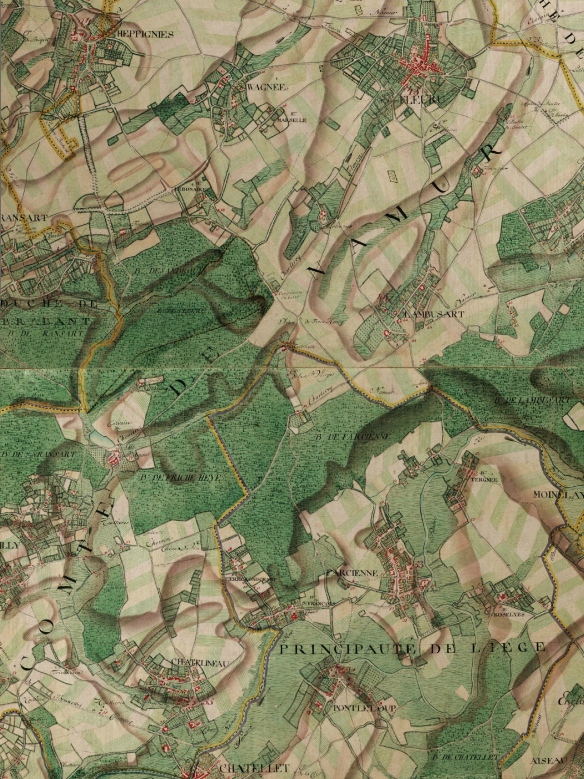
Ferraris map zone of the Gilly area. Gilly is about 2/3 down on left side. Shows the woods behind the initial Prussian line of defense.
For interested parties, my Ligny blog posts: Ligny Part I, Ligny Part II AAR
WR is looking forward to play testing this small scenario. Never know if the scenario initial design works and holds to expectations till the dice rolling commences. A future AAR report when completed. Reference books for my battle of Gilly 1815 scenario apart from the normal Waterloo 1815 campaign materials.
Cheers from the warren.
WR

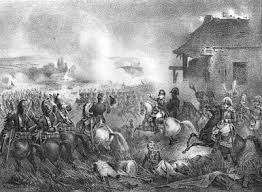
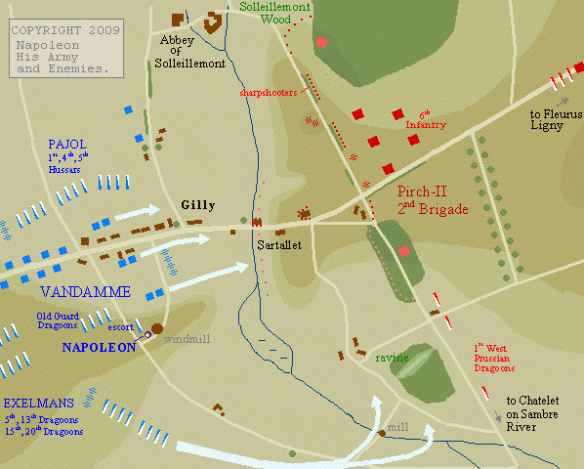


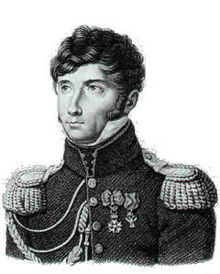
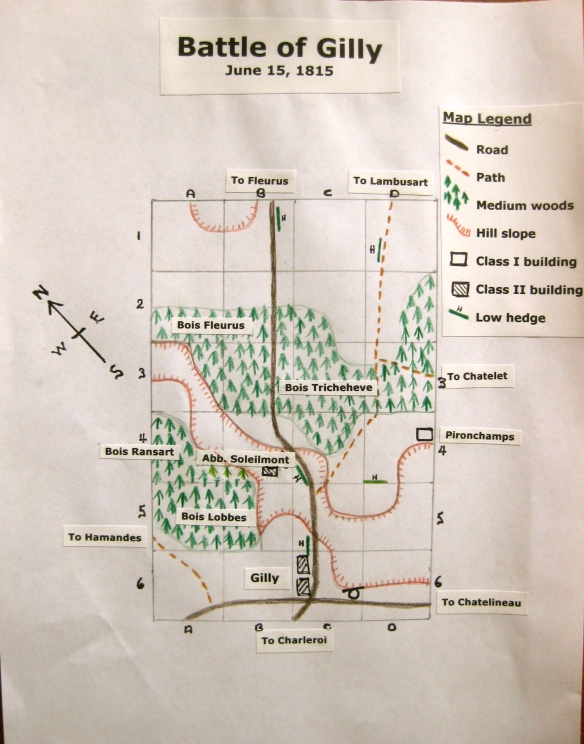
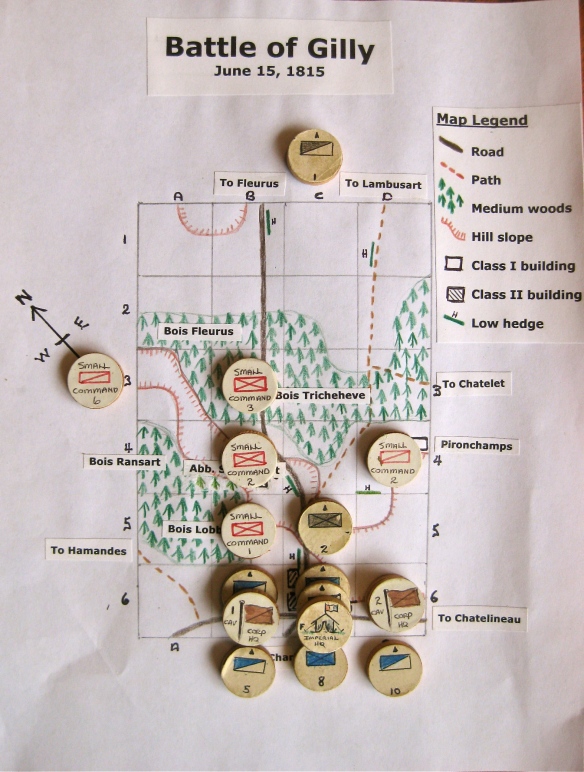
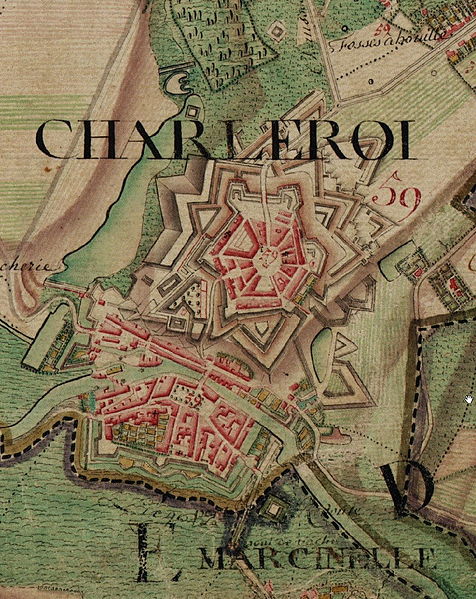
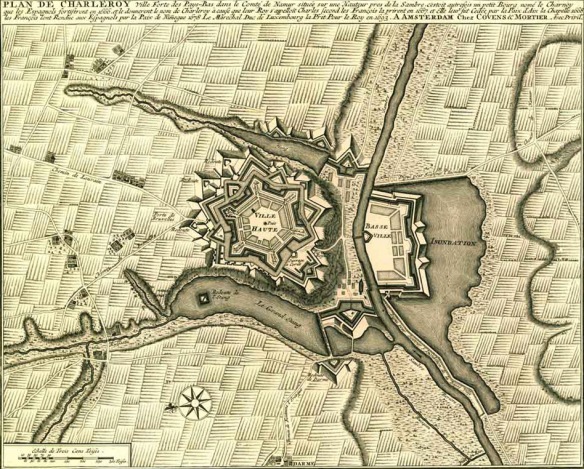


The new scenario looks great! The focus on getting Prussians off the table in decent order I think is the right way to go about it. The rules you guys use with the charge threat checks will also make the whole scenario quite interesting.
I’ve tried my hand at crafting Gilly as well, but ended up abandoning the idea because of the gross mismatch in forces. By 6pm Zieten had already won the battle (skirmish) of Gilly, Vandamme’s tired troops (having stepped off that morning at ~6 am) had been delayed 3+ hours. The Prussian OOB is (believe it or not) potentially too strong.
The 4th Hussars (1st Silesian) and the 6th Uhlans are covering the retreat of the 1st Brigade at Gosslies and then the pursuit by Girard’s 7th Division (who have been marching since 3:30am when Reille’s corps stepped off; If I remember 7th division is the most advanced unit of the Army du Nord at the close of the 15th and covered the greatest distance of the French infantry).
The 1st battalion of the 2nd Westphalian landwehr is also short as company or two that were cutoff on the wrong side of the Pieton and retreated with Steinmetz’s First Brigade via Gosslies (potentially not worth modelling). Steinmetz does not make St. Amand until 11pm, whether the
Von Pirch II also had an abattis prepared on the Fleurus road past the Abby of Soleilmont. I believe this might would be worth adding to your scenario and would slightly help offset the vast force disparity.
An additional “what if” is the garrison from 3rd Brigade at Farcienes (detachment of Silesian Schutzen and III(F)/7th IR.) being able to join as reinforcements covering the retreat. This garrison would have to be withdrawn once Von Pirch was forced to retreat. The garrison is mentioned as in place by Siborne prior to the start of the battle at 6pm. I know of no source indicating this force took part in the battle other than being on the extreme left flank observing the crossing on the Sambre.
My main source for all of this is Siborne, pages ~95-110 depending on your edition (and thus its value depends on your view of Siborne’s credibility).
One of my very first blog posts concerned June 15th: http://malefricmusings.blogspot.com/2012/01/which-way-to-fleurus-part-ii-french.html
Malefric,
Read your blog article. Nice and quick summary of the June 15th events. Thank you for looking/reading my efforts to highlight the action (battle) at Gilly.
Looking over the Prussian OOB and scenario notes. My thoughts…
The 4th Hussars (1st Silesian) I concur were with the 1st Brigade during the daylight hours and rejoined the Reserve cavalry of 1st Korps sometimes during the night. So if they were out of the area near Gilly then I must account for the mentioned “three” or maybe “four” regiments who faced down the French cavalry advance near Lambusart. One for sure was the Brandenburg dragoons, the other three choices could be: Brandenburg uhlans, 1st and 2nd Kurmark Landwehr cavalry, a portion of the 4th Hussars (1st Silesian) and the 1st Westphalian Landwehr cavalry. I can rule out the 1st Westphalian cavalry since I am aware they were with the 2nd Brigade’s retirement so that leaves the selection of the remaining three regiments which held back the French cavalry late evening advance near Lambusart. On a good second thought and reading my available sources they must be the Brandenburg Uhlans and both of the Kurmark Landwehr cavalry since no mention is given of these regiments being eslewhere on June 15th. This leaves the 6th Uhlans (ex Lutzow) and the 4th Hussars to cover the 1st Brigade.
Normally I would have the 2nd Westphalian Landwehr at a 3×8 battalions (2400 men) for our gaming scale (90:1 for this scenario) but with the losses of the Fus/2nd Westfalian battalion during the morning of the 15th I just used three battalion of 6 miniatures (6×90=540/battalion) representation. My Westphalian landwehr battalions are painted with a 6 miniature formation strength each. I could enlarge the 1st and 2nd battalions and reduce the 3rd to 2 miniatures… hmmm… interesting thought.
I am aware the 3rd Brigade played a very minor role and mostly at Lambusart late evening. I wanted the scenario to end before any tabletop action could be gamed in Lambusart so I deliberately kept the 3rd Brigade out of the scenario.
No problems with Siborne in my view. I look for all possible information sources and review all the material I can examen.
I left the abattis out of the scenario since a crafty Prussian would use it to shield his infantry from the French cavalry. No mentioned effect I noticed reading the accounts in my library.
Lastly, I used a large “wooded area” on my maps. Several maps tended to show lots of open ground behind Gilly and towards Fleurus. If this was true then why don’t the French cavalry pin the Prussian squares till the French infantry arrived. I think the ground had more woods (like the battle diagram in Peter H’s book) but the woods were passable for walking cavalry.
Thanks again for reading my blog. I will make the Prussian OOB scenario changes discussed above.
Michael aka WR
Interesting action, and probably worth playing as a game sometime myself.
Thank you Peter. I still have the Gilly scenario play test game to perform which hopefully will give a decent AAR to write up. I just added a link to the famous Ferraris map of Belgium 1778 to the Gilly blog page. Worth a visit and supports my terrain design for the scenario.
Battle of Alexandria 1801 scenario is next post. Have a HMGS-PSW convention next weekend for the Alexandria 1801 scenario. British vs. those French “Orientals.”
M